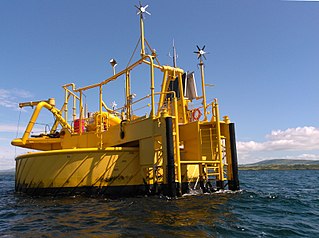Related Research Articles

A flange is an external or internal ridge, or rim (lip), for strength, as the flange of an iron beam such as an I-beam or a T-beam; or for attachment to another object, as the flange on the end of a pipe, steam cylinder, etc., or on the lens mount of a camera; or for a flange of a rail car or tram wheel. Thus flanged wheels are wheels with a flange on one side to keep the wheels from running off the rails. The term "flange" is also used for a kind of tool used to form flanges. Pipes with flanges can be assembled and disassembled easily.

A fire hydrant is a connection point by which firefighters can tap into a water supply. It is a component of active fire protection. Underground fire hydrants have been used in Europe and Asia since at least the 18th century. Above-ground pillar-type hydrants are a 19th-century invention.

In the oil and gas industry, the term wireline usually refers to the use of multi-conductor, single conductor or slickline cable, or "wireline", as a conveyance for the acquisition of subsurface petrophysical and geophysical data and the delivery of well construction services such as pipe recovery, perforating, plug setting and well cleaning and fishing. The subsurface geophysical and petrophysical information results in the description and analysis of subsurface geology, reservoir properties and production characteristics.

A drilling rig is an integrated system that drills wells, such as oil or water wells, in the earth's subsurface. Drilling rigs can be massive structures housing equipment used to drill water wells, oil wells, or natural gas extraction wells, or they can be small enough to be moved manually by one person and such are called augers. Drilling rigs can sample subsurface mineral deposits, test rock, soil and groundwater physical properties, and also can be used to install sub-surface fabrications, such as underground utilities, instrumentation, tunnels or wells. Drilling rigs can be mobile equipment mounted on trucks, tracks or trailers, or more permanent land or marine-based structures. The term "rig" therefore generally refers to the complex equipment that is used to penetrate the surface of the Earth's crust.

In petroleum and natural gas extraction, a Christmas tree, or "tree", is an assembly of valves, spools, and fittings used to regulate the flow of pipes in an oil well, gas well, water injection well, water disposal well, gas injection well, condensate well and other types of wells. It was named for its resemblance to the series of starting lights at a drag racing strip, called by that name.

National Oilwell Varco (NOV) is an American multinational corporation based in Houston, Texas. It is a leading worldwide provider of equipment and components used in oil and gas drilling and production operations, oilfield services, and supply chain integration services to the upstream oil and gas industry. The company conducts operations in more than 600 locations across six continents, operating through three reporting segments: Rig Technologies, Wellbore Technologies, and Completion & Production Solutions.

Casing is a large diameter pipe that is assembled and inserted into a recently drilled section of a borehole. Similar to the bones of a spine protecting the spinal cord, casing is set inside the drilled borehole to protect and support the wellstream. The lower portion is typically held in place with cement. Deeper strings usually are not cemented all the way to the surface, so the weight of the pipe must be partially supported by a casing hanger in the wellhead.

A blowout preventer (BOP) is a specialized valve or similar mechanical device, used to seal, control and monitor oil and gas wells to prevent blowouts, the uncontrolled release of crude oil or natural gas from a well. They are usually installed in stacks of other valves.
Artificial lift refers to the use of artificial means to increase the flow of liquids, such as crude oil or water, from a production well. Generally this is achieved by the use of a mechanical device inside the well or by decreasing the weight of the hydrostatic column by injecting gas into the liquid some distance down the well. A newer method called Continuous Belt Transportation (CBT) uses an oil absorbing belt to extract from marginal and idle wells. Artificial lift is needed in wells when there is insufficient pressure in the reservoir to lift the produced fluids to the surface, but often used in naturally flowing wells to increase the flow rate above what would flow naturally. The produced fluid can be oil, water or a mix of oil and water, typically mixed with some amount of gas.

A well intervention, or well work, is any operation carried out on an oil or gas well during, or at the end of, its productive life that alters the state of the well or well geometry, provides well diagnostics, or manages the production of the well.

See snubber for a device used to suppress ("snub") voltage transients in electrical systems

A Single buoy mooring (SrM) is a loading buoy anchored offshore, that serves as a mooring point and interconnect for tankers loading or offloading gas or liquid products. SPMs are the link between geostatic subsea manifold connections and weathervaning tankers. They are capable of handling any tonnage ship, even very large crude carriers (VLCC) where no alternative facility is available.

Q4000 is a multi-purpose oil field construction and intervention vessel ordered in 1999 by Cal Dive International, and was built at the Keppel AmFELS shipyard in Brownsville, Texas for $180 million. She was delivered in 2002 and operates under the flag of the United States. She is operated by Helix Energy Solutions Group. The original Q4000 concept was conceived and is owned by SPD/McClure. The design was later modified by Bennett Offshore, which was selected to develop both the basic and detailed design.

A drilling riser is a conduit that provides a temporary extension of a subsea oil well to a surface drilling facility. Drilling risers are categorised into two types: marine drilling risers used with subsea blowout preventer (BOP) and generally used by floating drilling vessels; and tie-back drilling risers used with a surface BOP and generally deployed from fixed platforms or very stable floating platforms like a spar or tension leg platform (TLP).

Offshore oil spill prevention and response is the study and practice of reducing the number of offshore incidents that release oil or hazardous substances into the environment and limiting the amount released during those incidents.
Following is a Timeline of the Deepwater Horizon oil spill for May 2010.
Efforts to stem the Deepwater Horizon oil spill were ongoing from the time that the Deepwater Horizon exploded on 4/20/2010 until the well was sealed by a cap on July 15, 2010. Various species of dolphins and other mammals, birds, and the endangered sea turtles have been killed either directly or indirectly by the oil spill. The Deepwater Horizon spill has surpassed in volume the 1989 Exxon Valdez oil spill as the largest ever to originate in U.S.-controlled waters; it is comparable to the 1979 Ixtoc I oil spill in total volume released.
An Emergency Disconnect Package (EDP) is a piece of equipment used in the drilling and work-over of deep sea oil & gas wells, by Mobile Offshore Drilling Rigs (MODU's) and Well Intervention Vessels (WIV's). The EDP is designed for use in an emergency, when the MODU or WIV needs to quickly disconnect, and move away from the oil/gas well that it is drilling or working-over. Examples of when this might be necessary include unexpected extreme weather that exceeds the MODU/Vessel's capability to maintain its position.
Alvheim Field is a Norwegian oil and gas field located in the northern part of the North Sea near the border with the British sector, consisting mainly of Boafält, Kneler Field and Kameleon Field. Parts of the Boafält are located in the British sector at block 9/15. The reservoir consists of early-tier sandstone. The depth of the area is 120–130 meters. The production ship is located approximately 12 km west of Heimdal Gassenter, at 59.56684°N 1.99731°E.
References
| This technology-related article is a stub. You can help Wikipedia by expanding it. |